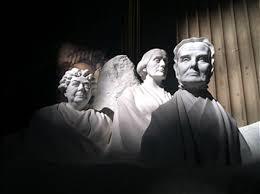
“As you know, the Equal Rights Amendment, which proposed banning discrimination based on sex, was passed by Congress in 1972 but was never ratified by the states and therefore has not been made part of the U.S. Constitution.”
This was one of a number of difficult reminders I had as my friends and I followed the National Women’s History Museum tour, an experience fraught with irony given that there isn’t actually a National Women’s History Museum. Instead, a young woman with a three ring binder led us along the route of the 1913 Suffrage parade, through the littered streets of our Nation’s capital. As she stopped to show us pictures from the plastic sleeves in her binder, I realized how little most of us know of the women who fought for nearly 80 years to secure women’s right to vote, including the suffragists who were jailed, brutalized, and force-fed in a D.C. prison precisely 100 years ago. The crime? Picketing the White House for the right to vote. The charge? Obstructing sidewalk traffic.
A wide array of national museums have been established and supported by congress such as The National Museum of African-American History and Culture, The National Museum of the American Indian, and the United States Holocaust Memorial Museum, to name few. Our tour guide explained that legislation to similarly establish and support The National Women’s History Museum goes before Congress this year. While I was touched by her optimism, we mustn’t be naive. Of the dozens of statues throughout our capital, our guide could only recall two that celebrate the contributions of specific women. One of those statues, the monument of Lucretia Mott, Elizabeth Cady Stanton, and Susan B. Anthony, was brought out of its 76‑year confinement in the Capitol Crypt to the rotunda of the U.S. Capital in 1997, 77 years after the 19th amendment was at last ratified by three-fourths of our nation’s states.
It was shortly after my visit to D.C. that I saw “Wonder Woman”. If you haven’t seen it yet, do. The heroine, Diana, the Roman name for the goddess Artemis, protector of girls, offers far more than the stereotypical female perspective she utters at the movie’s close - that only love will save the world. Because this, in the end, is not what saves the world. It’s her action - the physical force she summons to overcome the fear, hate, and war she encounters. Like many women who have seen Wonder Woman, I quietly wept while watching the fight scenes. My husband and daughter asked why. It was at once obvious yet hard to explain. What some women have said is that they didn’t realize how powerless they felt until they saw a movie which celebrates the triumph of the female perspective through raw, unfettered physical force.
While the force is most definitely female at the all girls school where I work, generally speaking the force will only be female when women organize, exert their collective power and stop waiting politely for the world to give us permission. The first step is recognizing how pervasive and insidious sexism still is. As I wrote this piece, thirteen male members of Congress were drafting health care legislation that would have rolled back women’s reproductive rights. May we look to female Senators such as Susan Collins, Kirsten Gillibrand, Kamala Harris, and Lisa Murkowski who voted no, as well as to the women of the suffrage movement, for courage.
